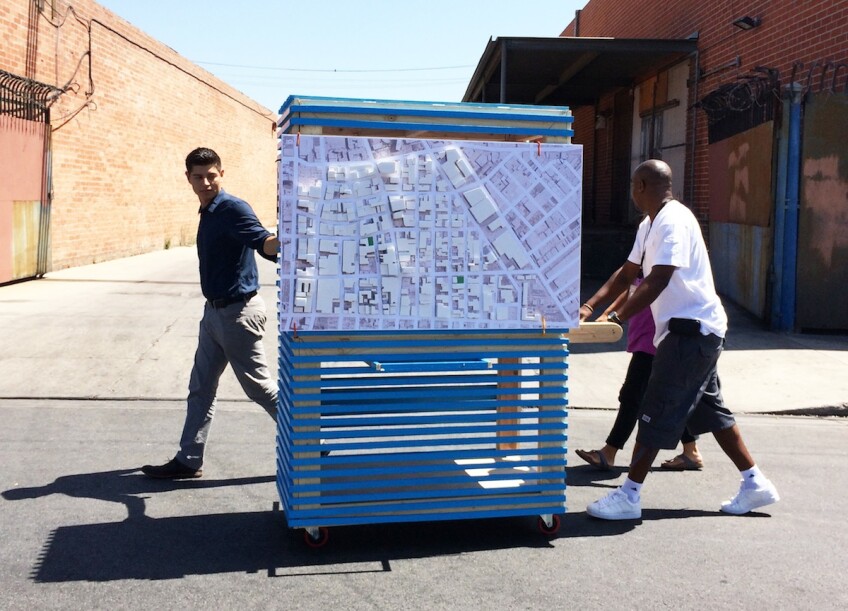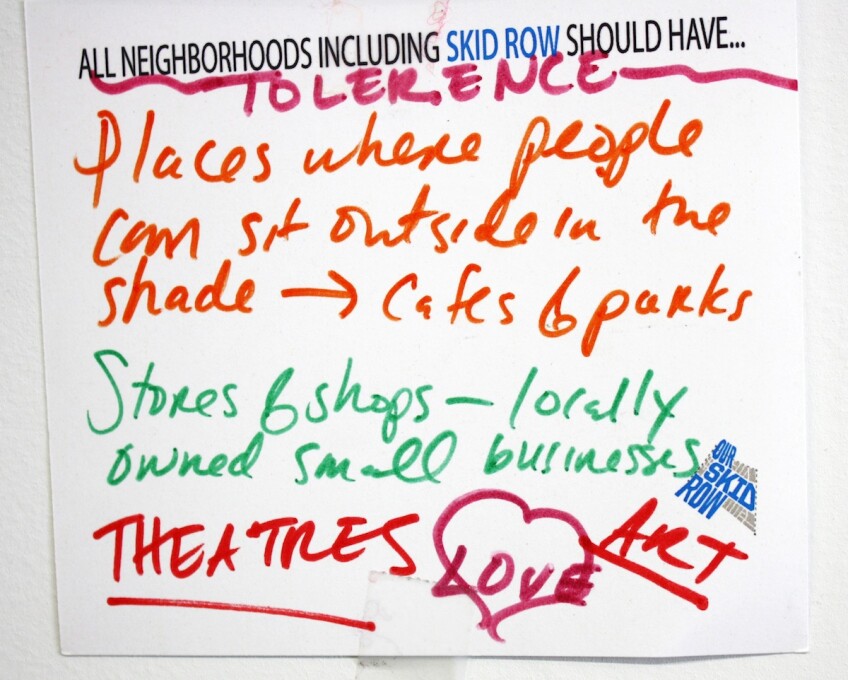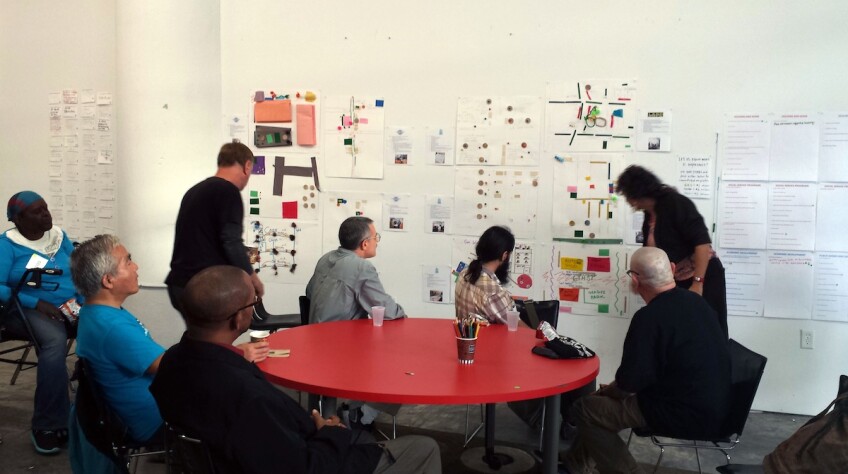Skid Row Residents Re-Imagine the Streets They Call Home


The Los Angeles City Council and Los Angeles County Board of Supervisors recently unveiled plans to address homelessness in the region, woping with a 20 percent rise in the number of individuals living on the street in 2015 over the previous year. Plans unveiled by Mayor Garcetti recently promised to allocate as much as $130 million for housing and services spanning from downtown L.A. to Venice. But a lesser known plan of action has also recently been released by the Skid Row community itself: a general neighborhood vision plan with proposed enhancements to the area like information kiosks with cell phone charging stations, mobile hygiene services with showers and storage lockers, day care center, mediation centers and street improvements like speed bumps to slow down traffic in the highly-pedestrian areas. The plan sets out such guidelines for the Skid Row neighborhood that homeless advocates and community members hope will then be incorporated into the revised community general plan of downtown (this work is being done currently by local planning groups).
Vision plans like Skid Row's aren't unusual. Across California most communities draft plans like these to outline ways in which the neighborhood can secure funding for development, attract economic interests or preserve the aesthetic of the place through preservation or design review requirements. What is different about Skid Row's neighborhood plan, called “Our Skid Row,” is that it comes directly from the collective participation of a community group many assume lacks real bargaining power or organizational clout, let alone a clear vision for their own neighborhood. But why wouldn't the residents of Skid Row feel a sense of home, despite their homelessness?

“We thought people would ask for housing first, but people wanted hygiene first, they want to take a shower, wash their clothes,” say Mike Alvidrez, executive director of Skid Row Housing Trust. “These are folks who are typically not heard from. So we went out and asked them: 'What should Skid Row become?' We wanted the community to be heard and to be recorded and be manifested in a compilation or a document.” During more than 15 intensive design workshops, homeless community members sketched, drew, created models, and imagined solutions to improve the area and enhance the community in which they would like to continue to live. Skid Row Housing Trust was a partner with the community in the process of generating the report that came from the workshops. It was compiled over a year and a half, as residents attended and shared experiences about the importance of Skid Row.
Architect and community organizer Theresa Hwang helped to design the workshops so that the community members' input would inform the general plan, as opposed to bringing in an outsider urban planning consultant or some other agency. “The goal of the design workshops was to organize around a legible, intuitive process for community members that would build upon the experience of the neighborhood, because they are experts in that,” says Hwang.

Design workshop attendees sketched sections of the sidewalk and looked at the relationship of buildings in the private realm to the street in the public sector. In another, participants made models about corridors and connections in the area, and worked with paper and other mixed media collages. They also made compositions from their individual memories of the neighborhood and then overlaid representations of future desires or goals over the old ones.
“The idea was to do fun, creative, artistic workshops with un-intimidating materials which people could come to once, or continue coming back again. We had a lot of people return over and over again to hone their ideas,” says Hwang.
Inspired by the workshops, Skid Row community members initiated some of their workshops and offshoot events including a silkscreening poster and T-shirt workshop in San Julian Park to celebrate and create awareness of the creative and solidarity-minded side of Skid Row. At another workshop, neighborhood groups designed a 3D rolling map of the neighborhood they could take out to every block and corner of Skid Row -- the “participation station” -- that could move around the neighborhood garnering even more interaction and input by community members that might not feel comfortable attending a formal workshop at the Skid Row Design Studio.

In terms of the participation station Alvidrez says, “You gotta go out there and get them, sometimes there's no way for them to check in, or they aren't aware there is a workshop or they don't understand the value of a workshop.”
Alvidrez is confident the plans can come to fruition somehow. “The next step is to engage the stakeholders and implement some of the ideas that sustain aspects of the plan -- open space, parks, showers -- we do have some limited funds to effectuate this,” he says. But more than an advocacy tool or a wish list of services, the most significant aspect brought about by the Our Skid Row initiative is that it gives the community's place in downtown legitimacy, and allows them to express their shared desires and deep feelings of responsibility for the neighborhood.
“Yes, Skid Row needs money and services, but what is just as important is the notion that we need to re-understand homelessness, understanding what any of us would need,” Alvidrez says. “There is value in putting yourself in someone else's shoes. These folks aren't so different from anybody else. We all respond to the same things, that's a commonality with all humanity. The better we do at figuring that out -- the better the buildings will be from the inside out.”

Top image: Artist Rosten Woo collaborated with organization Our Skid Row in 2015 to illustrate "what Skid Row might look like if Skid Row’s residents had their way."